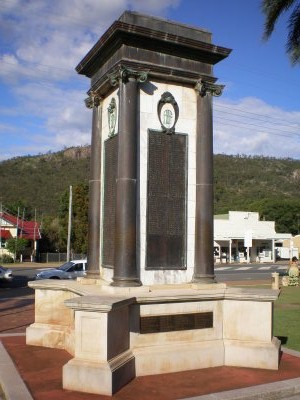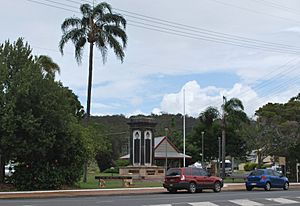Esk War Memorial facts for kids
Quick facts for kids Esk War Memorial |
|
|---|---|

Esk War Memorial, 2010
|
|
| Location | Ipswich Street, Esk, Somerset Region, Queensland, Australia |
| Design period | 1919 – 1930s (interwar period) |
| Built | 1920–1991 |
| Architect | George Brockwell Gill |
| Official name: Esk War Memorial and Esk Memorial Park | |
| Type | state heritage (built) |
| Designated | 21 October 1992 |
| Reference no. | 600494 |
| Significant period | 1921–(social) 1921–1991(historical, fabric-memorials) 1979–1985 (fabric – park) |
| Significant components | memorial – other, memorial/monument, park / green space |
| Builders | Frank Williams & Co |
| Lua error in Module:Location_map at line 420: attempt to index field 'wikibase' (a nil value). | |
The Esk War Memorial is a special memorial located on Ipswich Street in Esk, Queensland, Australia. It was designed by architect George Brockwell Gill and built in 1920 by Frank Williams & Co. This important site is also known as Esk Memorial Park. It was added to the Queensland Heritage Register on 21 October 1992, recognizing its historical value.
Contents
A Place to Remember: The History of Esk War Memorial
The Esk Memorial Park officially became a reserve for memorial purposes in 1979. However, a memorial for World War I (also known as the First World War) has stood at this spot since 1921.
Building the Memorial
The idea for the memorial came from the Esk Patriotic Committee. They worked on behalf of the local council, known as the Shire of Esk. People started donating money for the project in 1916.
In April 1919, famous Ipswich architect George Brockwell Gill asked for bids from builders. The first stone of the memorial was placed on 30 November 1920. The memorial was officially revealed on 28 September 1921 by General Lachlan Chisholm Wilson.
The stone work was done by Frank Williams & Co. from Ipswich. The metal parts were made by Wunderlich Ltd from Sydney. The whole project cost £885 at the time.
Park Changes Over Time
In 1983, the memorial park was made larger. A stone memorial to Captain Patrick Logan was added to the park in 1984. Captain Logan was a commandant of the Moreton Bay Penal Settlement who was killed while exploring in 1830. The park's gardens and paths were improved in 1985.
In 1988, some of the letters on the First World War memorial were fixed. Two plaques were added to remember Australians who served in conflicts after 1945. In 1991, another plaque was added to honor those who died in the Second World War.
What the Esk War Memorial Looks Like
Esk Memorial Park is located on the main street of Esk. It has two stone monuments, along with paths and gardens.
The First World War Memorial
The First World War memorial is made of sandstone. It has a base, called a plinth, with four decorative columns, called pilasters, at its corners. The top part, called an entablature, is covered in bronze.
Each of the four sides has a marble panel with a bronze honour roll. These rolls list the names of 462 local people who joined the army, along with the letters AIF (Australian Imperial Force) and its symbol. The memorial stands on a stepped base made of concrete.
Honour Rolls and Plaques
Three bronze honour rolls are attached to the sides and back of the memorial's base. These rolls list the names of 83 local men who died during the First World War.
Four special plaques are fixed to the front of the base. They have inscriptions for:
- 1939 – World War II 1945
- 1914 – The Great War – In Honour Of Our Boys – 1919
- Korea – Malaya
- Borneo – Vietnam
Captain Logan Memorial
Also in the park is a memorial for Captain Logan. This is a single, tall sandstone block. A bronze plaque with white writing is attached to its northern side.
Park Features
The park has native trees and palm trees. It also includes pathways, a barbecue area, places to sit, and a playground for children.
Why Esk War Memorial is Important
The Esk War Memorial was added to the Queensland Heritage Register on 21 October 1992. This means it's recognized as a very important historical site for several reasons:
Showing Queensland's History
The memorial, built in 1921, helps us understand Queensland's history. It shows how people felt about Australian patriotism and Australian nationalism during and right after the First World War (1914–1918). It's a sign of a big social movement at that time.
A Special Type of Memorial
This First World War Memorial is a great example of a certain type of monument. These structures were built to remember the local impact of a major historical event. They were made to last a long time. This memorial is a significant example of its kind in the region.
Beautiful and Well-Made
The memorial has a special beauty that the community values. Its design and craftsmanship are excellent. The memorial and the park together add a lot to the look and feel of the town of Esk.
Important to the Community
This place is very important to the Esk community. It's a public way for them to remember and honor the local people who took part in major historical events.
Linked to a Famous Architect
The memorial is also important because it's an unusual example of the work of Ipswich architect G.B. Gill.


